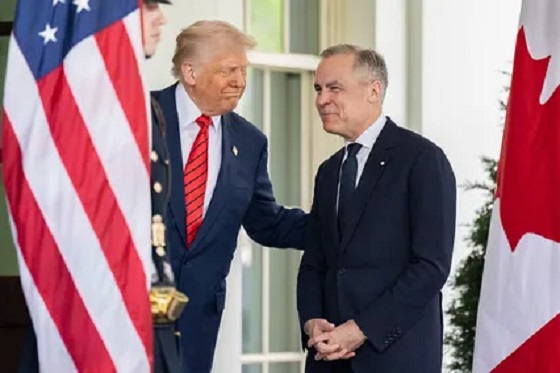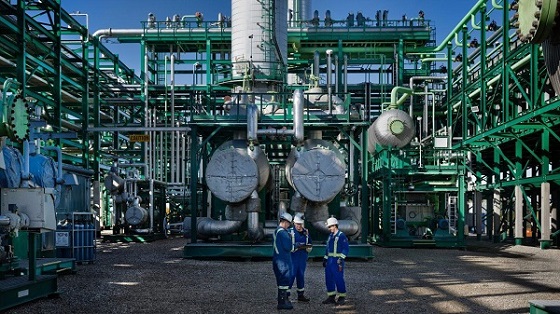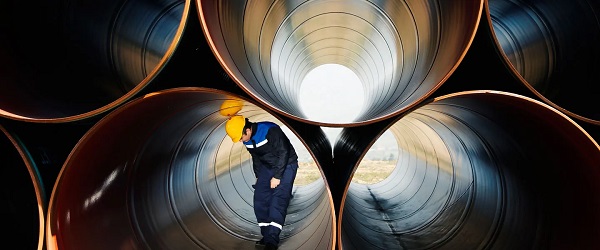Economy
Credits where credit is due: LNG exports and carbon credits

From the MacDonald Laurier Institute
By Jerome Gessaroli
Canada should announce its intent to use Article 6 as a tool to help meet its emissions reduction targets
In this new paper, LNG exports and carbon credits: Credits where credit is due, MLI Senior Fellow Jerome Gessaroli makes the case that Canada can earn ITMOs ( Internationally Transferable Mitigation Outcomes) based on exports of British Columbia-sourced Liquified Natural Gas (LNG). With the potential to significantly lower global carbon emissions and displace coal power in the Asia-Pacific region, such a strategic move by Canada to harness BC’s LNG offers a transformative solution.
Executive Summary
Under the basic current climate accounting rules to which Canada and all other UNFCCC parties have agreed, countries are responsible for reducing GHG emissions within their own national borders. If a country supported a project in another country, it would receive zero credit, no matter what help it may have provided. Therefore, countries have a big incentive to fund projects only within their own borders to help meet their own national carbon reduction goals. That is unfortunate for the planet’s emission reduction efforts. The focus on emission targets within national borders is a shortfall in the nationally based climate accounting system.
To address this shortcoming, the UNFCCC has adopted a framework covered in Article 6 of the Paris Agreement enabling countries to cooperate and share emission reductions. This framework allows carbon credits (known as internationally transferable mitigation outcomes, or ITMOs) to be transferred from the country where the reductions occurred to the country that helped undertake the emissions reduction project.
Sharing emissions reductions through Article 6 is possible when liquefied natural gas (LNG) replaces coal in power generation. This substitution is especially important because coal-fired power plants are expected to produce large amounts of the world’s energy (and GHGs) over the next several decades, even though coal emits much more carbon than other primary fuel sources. Even more troublesome is that new coal plants are still being built in significant numbers. Those new plants alone are expected to emit over 1,415 Mt CO2e (mega tonnes of CO2 equivalent) per year, which dwarfs Canada’s national targeted reductions of approximately 310 Mt CO2e per year by 2030.
Canada, meanwhile, is preparing to become a supplier of LNG. New LNG projects within British Columbia are amongst the least carbon-intensive sources of LNG in the world. BC’s LNG exports could lower global carbon emissions by displacing coal power, particularly in the Asia-Pacific region. Developing markets in Asia would welcome rapidly rising LNG imports. Realistically, BC LNG should be fully used as a substitute fuel to mitigate the carbon emissions impact of existing coal-based power plants, especially those currently used for heating.
While the concept of Article 6, where carbon credits are shared for collaboratively developed projects, is straightforward, the criteria and rules for implementing it are complex. This paper makes the case for how Canada can earn ITMOs based on exports of British Columbia-sourced LNG. An important criterion for making projects ITMO eligible is that the project would not have gone ahead without carbon credits being available. This suggests deals should be structured involving LNG exports along with some other value-added Canadian participation that assists a developing country in switching from coal to LNG as a fuel source. The ITMOs Canada receives could offset any incremental costs we would incur.
If Article 6 is used, the assertion that British Columbia’s pursuit of LNG production would prevent the province from meeting its emission reduction becomes inaccurate. Just over half of LNG Canada’s Phase 1 production capacity in British Columbia would result in approximately 1.2 Mt CO2e emissions annually. Using the same production capacity to replace coal for power generation in Asia has the potential to significantly reduce emissions, ranging from 14.9 to 35.2 Mt CO2e per year. Such outcomes underscore the importance of international collaborative efforts.
Canada should announce its intent to use Article 6 as a tool to help meet its emissions reduction targets. The federal government should then work with industry to identify candidates for bilateral agreements. Common methodologies for measuring, tracking, and verifying carbon mitigation outcomes would all need to be developed as would a registry for tracking and transferring ITMOs. These are complex issues, but we can learn from other countries that have already established processes for managing such projects.
Jerome Gessaroli is a senior fellow with the Macdonald-Laurier Institute and is the project lead for the British Columbia Institute of Technology’s Sound Economic Policy Project. He writes on economic and environmental matters, from a market-based principles perspective.
Business
Most Canadians say retaliatory tariffs on American goods contribute to raising the price of essential goods at home

- 77 per cent say Canada’s tariffs on U.S. products increase the price of consumer goods
- 72 per cent say that their current tax bill hurts their standard of living
A new MEI-Ipsos poll published this morning reveals a clear disconnect between Ottawa’s high-tax, high-spending approach and Canadians’ level of satisfaction.
“Canadians are not on board with Ottawa’s fiscal path,” says Samantha Dagres, communications manager at the MEI. “From housing to trade policy, Canadians feel they’re being squeezed by a government that is increasingly an impediment to their standard of living.”
More than half of Canadians (54 per cent) say Ottawa is spending too much, while only six per cent think it is spending too little.
A majority (54 per cent) also do not believe federal dollars are being effectively allocated to address Canada’s most important issues, and a similar proportion (55 per cent) are dissatisfied with the transparency and accountability in the government’s spending practices.
As for their own tax bills, Canadians are equally skeptical. Two-thirds (67 per cent) say they pay too much income tax, and about half say they do not receive good value in return.
Provincial governments fared even worse. A majority of Canadians say they receive poor value for the taxes they pay provincially. In Quebec, nearly two-thirds (64 per cent) of respondents say they are not getting their money’s worth from the provincial government.
Not coincidentally, Quebecers face the highest marginal tax rates in North America.
On the question of Canada’s response to the U.S. trade dispute, nearly eight in 10 Canadians (77 per cent) agree that Ottawa’s retaliatory tariffs on American products are driving up the cost of everyday goods.
“Canadians understand that tariffs are just another form of taxation, and that they are the ones footing the bill for any political posturing,” adds Ms. Dagres. “Ottawa should favour unilateral tariff reduction and increased trade with other nations, as opposed to retaliatory tariffs that heap more costs onto Canadian consumers and businesses.”
On the issue of housing, 74 per cent of respondents believe that taxes on new construction contribute directly to unaffordability.
All of this dissatisfaction culminates in 72 per cent of Canadians saying their overall tax burden is reducing their standard of living.
“Taxpayers are not just ATMs for government – and if they are going to pay such exorbitant taxes, you’d think the least they could expect is good service in return,” says Ms. Dagres. “Canadians are increasingly distrustful of a government that believes every problem can be solved with higher taxes.”
A sample of 1,020 Canadians 18 years of age and older was polled between June 17 and 23, 2025. The results are accurate to within ± 3.8 percentage points, 19 times out of 20.
The results of the MEI-Ipsos poll are available here.
* * *
The MEI is an independent public policy think tank with offices in Montreal, Ottawa, and Calgary. Through its publications, media appearances, and advisory services to policymakers, the MEI stimulates public policy debate and reforms based on sound economics and entrepreneurship.
Business
Trump confirms 35% tariff on Canada, warns more could come

Quick Hit:
President Trump on Thursday confirmed a sweeping new 35% tariff on Canadian imports starting August 1, citing Canada’s failure to curb fentanyl trafficking and retaliatory trade actions.
Key Details:
- In a letter to Canadian Prime Minister Mark Carney, Trump said the new 35% levy is in response to Canada’s “financial retaliation” and its inability to stop fentanyl from reaching the U.S.
- Trump emphasized that Canadian businesses that relocate manufacturing to the U.S. will be exempt and promised expedited approvals for such moves.
- The administration has already notified 23 countries of impending tariffs following the expiration of a 90-day negotiation window under Trump’s “Liberation Day” trade policy.
Diving Deeper:
President Trump escalated his tariff strategy on Thursday, formally announcing a 35% duty on all Canadian imports effective August 1. The move follows what Trump described as a breakdown in trade cooperation and a failure by Canada to address its role in the U.S. fentanyl crisis.
“It is a Great Honor for me to send you this letter in that it demonstrates the strength and commitment of our Trading Relationship,” Trump wrote to Prime Minister Mark Carney. He added that the tariff response comes after Canada “financially retaliated” against the U.S. rather than working to resolve the flow of fentanyl across the northern border.
Trump’s letter made clear the tariff will apply broadly, separate from any existing sector-specific levies, and included a warning that “goods transshipped to evade this higher Tariff will be subject to that higher Tariff.” The president also hinted that further retaliation from Canada could push rates even higher.
However, Trump left the door open for possible revisions. “If Canada works with me to stop the flow of Fentanyl, we will, perhaps, consider an adjustment to this letter,” he said, adding that tariffs “may be modified, upward or downward, depending on our relationship.”
Canadian companies that move operations to the U.S. would be exempt, Trump said, noting his administration “will do everything possible to get approvals quickly, professionally, and routinely — In other words, in a matter of weeks.”
The U.S. traded over $762 billion in goods with Canada in 2024, with a trade deficit of $63.3 billion, a figure Trump called a “major threat” to both the economy and national security.
Speaking with NBC News on Thursday, Trump suggested even broader tariff hikes are coming, floating the idea of a 15% or 20% blanket rate on all imports. “We’re just going to say all of the remaining countries are going to pay,” he told Meet the Press moderator Kristen Welker, adding that “the tariffs have been very well-received” and noting that the stock market had hit new highs that day.
The Canadian announcement is part of a broader global tariff rollout. In recent days, Trump has notified at least 23 countries of new levies and revealed a separate 50% tariff on copper imports.
“Not everybody has to get a letter,” Trump said when asked if other leaders would be formally notified. “You know that. We’re just setting our tariffs.”
-

 Business18 hours ago
Business18 hours agoMost Canadians say retaliatory tariffs on American goods contribute to raising the price of essential goods at home
-

 National1 day ago
National1 day agoWomen and girls beauty pageant urges dismissal of transgender human rights complaint
-

 Alberta18 hours ago
Alberta18 hours agoCross-Canada NGL corridor will stretch from B.C. to Ontario
-

 International2 days ago
International2 days agoSupport for the Ukraine war continues because no one elected is actually in charge.
-

 Business2 days ago
Business2 days agoTrump slaps Brazil with tariffs over social media censorship
-

 Business2 days ago
Business2 days agoCBC six-figure salaries soar
-

 Business19 hours ago
Business19 hours agoB.C. premier wants a private pipeline—here’s how you make that happen
-

 Addictions2 days ago
Addictions2 days agoCan addiction be predicted—and prevented?





